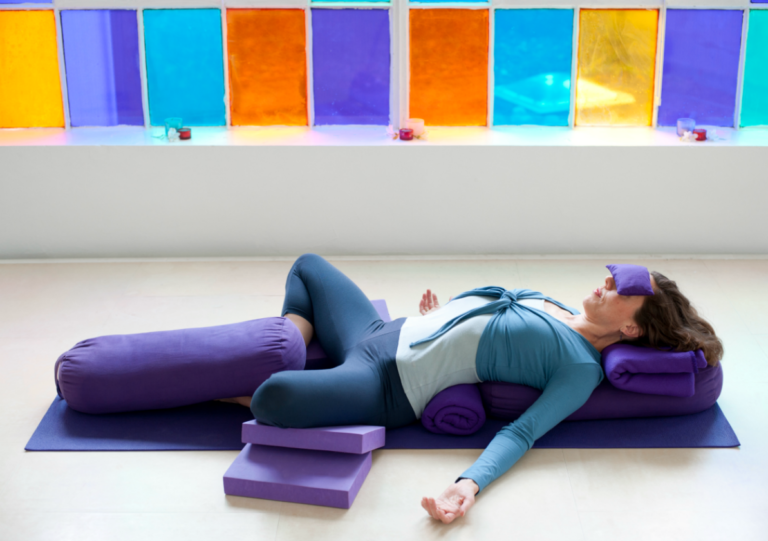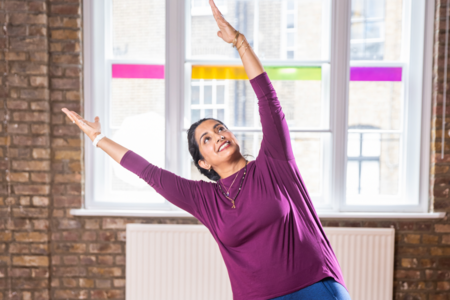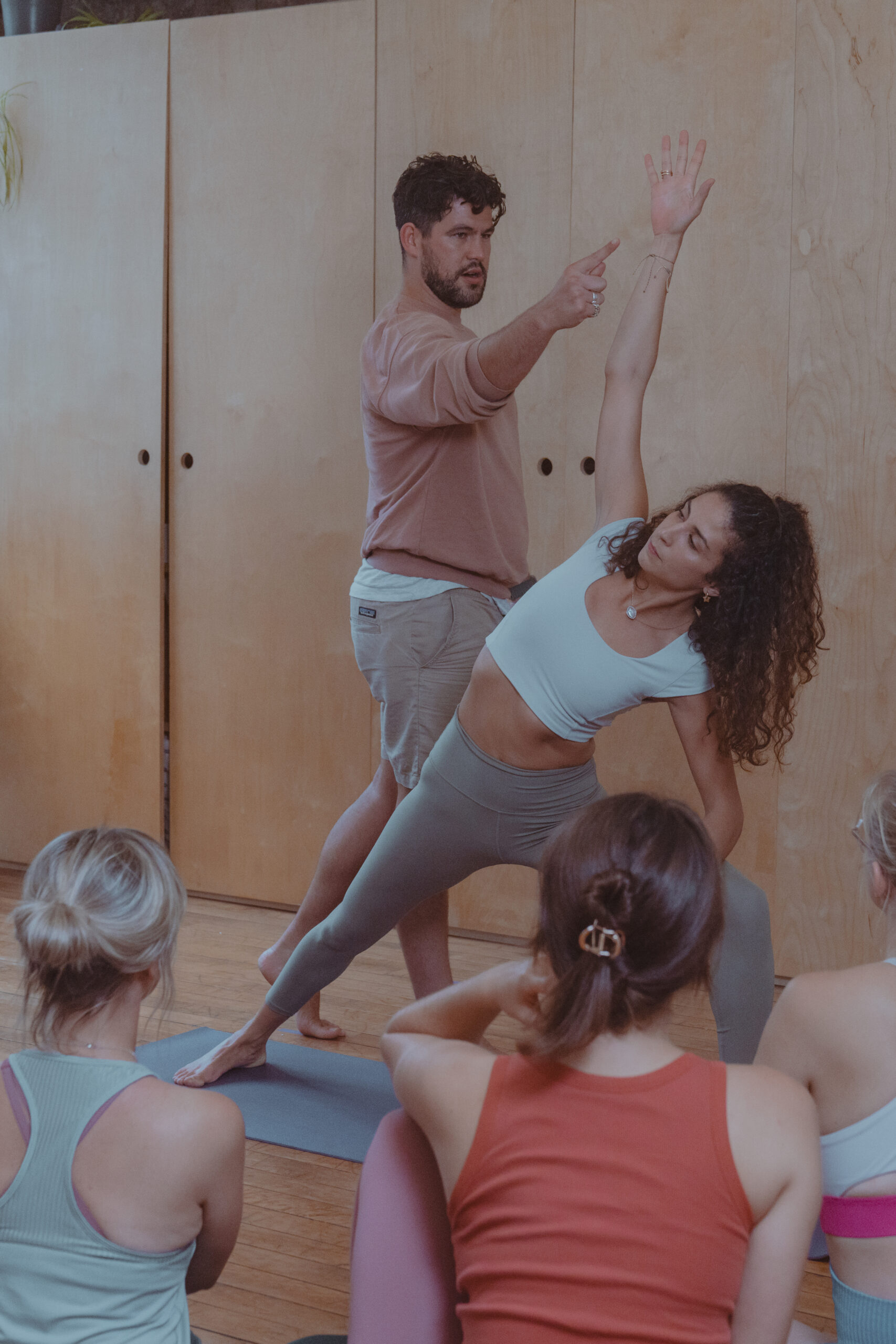It’s restorative yoga week for #everyonetriyoga. Read on for Anna Ashby’s introduction to the style, and then try it for yourself with any restorative class this week for a chance to win a spot on an upcoming restorative workshop.
Restorative yoga is a beautiful thing. It’s a mini yoga revolution of slowing down, opening, feeling support and being absolutely present to the energy of the moment. The purpose of this type of yoga practice is one of deep heartfelt opening and softening where the nervous system shifts out of ‘fight or flight’ into a relaxation response.
It evolved from the seminal work of BKS Iyengar. It uses props such as bolsters and blankets to support the body in different reclining positions and conscious breath to create space, not only physically but mentally as well. Sometimes this can take a while, because we spent quite a lot of time working ourselves into a highly stimulated state, where we are stuck in the mode of ‘doing’ and have forgotten the basic experience of human ‘being’.
Using slow conscious stretches to release physical tension and the power of natural breath to literally shift perception to one of space, the body can rest in the different supported postures. The brain perceives the opportunity to rest and engages the parasympathetic nervous system initiating a whole plethora of calming and rejuvenating activities from releasing the body from stress hormones, lowering blood pressure and heart rate, and improving digestion.
Environment in restorative yoga is important – turn off your phone so you won’t be interrupted; make sure you are warm so the body can soften; lower the lights to create a calm, restful environment – all of which help calm the nervous system.
And remember a relaxed and conscious breath is the main way to bring about the shift of the nervous system along with comfort, softening and opening and a willingness to let go of your attachment to the ‘doing’ of things. In fact restorative yoga is a process of ‘un-doing’.
You will come out feeling refreshed and rejuvenated. Restorative yoga completes a yoga practice balancing out an active one with a rejuvenating one. Consider adding a restorative yoga class per week to support your ongoing practice or adding a pose in before savasana, your final relaxation pose at the end of practice. Here is a simple restorative practice you can try at home; you will need a bolster, a strap, a couple of blankets and some pillows off your couch…if you have any medical conditions, ask your local yoga teacher about the suitability of the practice. Restorative practice is useful at any time of the day. Always leave yourself a little space after practice so that you can take in the nourishing energy of the practice and allow it to affect the quality of your perception and experience of the day.
Here is a simple restorative practice you can try at home; you will need a bolster, a strap, a couple of blankets and some pillows off your couch…if you have any medical conditions, ask your local yoga teacher about the suitability of the practice. Restorative practice is useful at any time of the day. Always leave yourself a little space after practice so that you can take in the nourishing energy of the practice and allow it to affect the quality of your perception and experience of the day.
1) Effortless Rest Pose – lie on the back with the knees bent; support the head with a blanket. Place the hands on the solar plexus and begin to focus on relaxed, soft and conscious breaths. (5 minutes) Benefit: gives time for settling and allows a deeper connection to conscious breath; encourages healthy posture.
2) Supta Padangushtasana 1 + 2 (reclining hamstring stretch and inner thigh stretch) Again lying flat with head supported use a strap around the foot and stretch the leg upwards. Firm the muscles of the leg as you stretch it. Stretch for 5 breaths then open the leg out to the side and again stretch for 5 breaths. Benefits: releases tension in the hips and legs and supports deeper fuller breathing.
3) Jathara Parivartanasana (revolved abdominal pose) Lying on the back shift the hips to the left; stretch the right leg down and draw the left knee into the chest. Inhale and on the exhale gently twist to the right drawing the knee across the body and over to the side. Draw the opposite shoulder back and open the arm out to the side and focus on lengthening the spine. Take 5 full breaths and then change sides. Benefits: releases the muscles that run along the spine; stretches the diaphragm; opens up the ribcage all helpful for deeper breathing.
4) Child’s Pose over a bolster – 5 minutes. Place a bolster vertically underneath the torso and hug it. Sit back onto the heels and turn the head to the side. Benefits – encourages relaxation and calms the nervous system. (If there are knee problems roll up a blanket and place it in between the buttock bones and the heels. If there is still pain, skip this pose.)
5) Supta Baddha Konasana – (reclining bound angle pose) Lie vertically over a bolster with your pelvis on the floor and your back from the waist upwards on the bolster; support the head with a blanket. Position the soles of the feet together opening the knees out to the sides. Support the knees with blankets or pillows. 5-10 minutes. Focus on a relaxed and full breath. Benefits: encourages relaxation and calms the nervous system; relieves fatigue. Releases abdominal and pelvic tension and opens hips.
6) Viparita karani – (legs up the wall pose) Swing legs up the wall and place a blanket underneath the head. Don’t be so close that the hamstrings are pulling. Relax the legs up the wall without them falling down. Benefits: Inversion which is extremely calming for the nervous system and refreshes the legs especially if you’ve been sitting or standing or both all day! Promotes good posture releasing tension from the neck and shoulders. Anna has been studying and practising yoga for 23 years and teaching for 15 years. She is one of London’s leading yoga teachers and a dedicated triyoga teacher. She is a founder and senior faculty member of triyoga’s teacher training program and holds the highest level of certification from Yoga Alliance both in the UK and in the US (E-RYT 500/Senior Teacher). Anna’s teaching style has evolved from her study of dance, in-depth training with established, classical yoga systems that focus on alignment, and a dedicated meditation practice that developed while she lived for 12 years in a yoga ashram in upstate New York. She has been teaching Restorative Yoga at triyoga for 10 years using the weekly classes to develop and refine her teaching of the restorative practices. https://www.annaashby.com/
Anna has been studying and practising yoga for 23 years and teaching for 15 years. She is one of London’s leading yoga teachers and a dedicated triyoga teacher. She is a founder and senior faculty member of triyoga’s teacher training program and holds the highest level of certification from Yoga Alliance both in the UK and in the US (E-RYT 500/Senior Teacher). Anna’s teaching style has evolved from her study of dance, in-depth training with established, classical yoga systems that focus on alignment, and a dedicated meditation practice that developed while she lived for 12 years in a yoga ashram in upstate New York. She has been teaching Restorative Yoga at triyoga for 10 years using the weekly classes to develop and refine her teaching of the restorative practices. https://www.annaashby.com/










